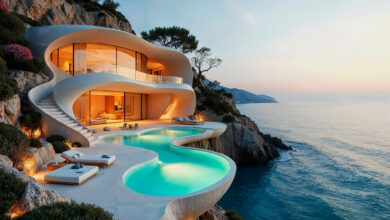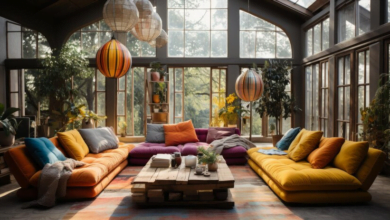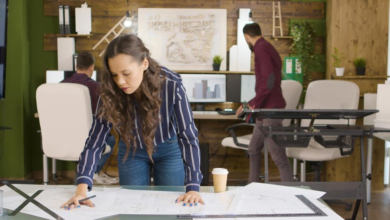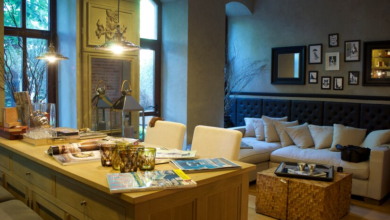Industrial Materials in 2025: It’s All About Raw and Rustic

Industrial interior design features the rugged beauty and raw authenticity of industrial materials. These elements, once reserved for factories and warehouses, have found their way into homes. In this blog post, I’m excited to explore the diverse types of materials and decor used in industrial interior design, shedding light on how you can incorporate them into your own home.
The Raw Beauty of Reclaimed Wood
With every knot and crack, reclaimed wood is a raw material that carries with it a sense of history, adding character and warmth to any space. Salvaged from old barns, factories, and warehouses, reclaimed wood has a natural texture and patina that creates a rich visual contrast against smoother elements. Wood, whether distressed or weathered can be used for flooring, ceiling beams, furniture, or accent pieces, to add depth and dimension to your industrial-style home.
The Power of Metals
Industrial design is incomplete without the use of exposed metal. From steel beams to wrought iron fixtures, metal accents give that industrial vibe to any room. Embrace the raw, unfinished look of metal surfaces, allowing them to lose their colour over time for a truly rustic feel. Incorporate metal elements into your decor through lighting fixtures, shelving units, and statement pieces. Whether you prefer polished metal for a modern look or beaten metal for a vintage charm, these metal accents are sure to make a bold statement in your industrial-inspired space.
Furthermore, pairing brushed brass fixtures with blackened iron accents creates a dynamic contrast that’s both modern and timeless. Corrugated metal panels or sheets are prominently used as wall coverings, room dividers, or even as ceiling treatments to introduce texture and industrial flair into the design.
Also Read: Industrial Design Trends
Concrete is the New Chic
Concrete on the list of industrial materials is a versatile option and has become recently popular in design. Its minimalist appearance and durable nature make it a favorite choice for floors, countertops, and walls. Go for exposed concrete if you deliberately want an unfinished look or opt for polished surfaces for a sleeker one. Pair concrete elements with warm woods and soft textiles to balance out its stark appearance and create a cozy atmosphere. Whether used sparingly as a statement piece or throughout an entire space, concrete is ready to make it all stand out in your industrial interior.
Celebrating Exposed Brick

Exposed brick walls are synonymous with industrial design, adding texture, warmth, and character to any room. Whether leaving its original red hue or brushed in a neutral tone, brick walls bring energy into your home. The rough, imperfect nature of brick makes it a beloved choice for both historic lofts and contemporary homes alike. Pair exposed brick walls with industrial lighting fixtures, vintage-inspired furniture, and soft textiles for an interesting and inviting space.
Balancing Industrial Materials with Soft Textiles and Natural Accents
While industrial materials are known for their rugged appearance, it’s essential to balance them with softer elements to create a cozy atmosphere. Pick luxurious textiles like wool rugs, faux fur throws, and velvet upholstery to add texture and warmth to your space. Introduce natural accents such as wood and leather to melt the hard edges of industrial design and create a harmonious balance.
Likewise, adding touches of greenery through houseplants can breathe life into your interior while complementing the raw beauty of industrial materials. By juxtaposing rough with soft, you’ll achieve a perfect balance for your industrial interior.
As an American interior designer, said:
Balance is everything in design, and it’s the secret to creating a truly beautiful space.
Kelly Wearstler
So, don’t shy away from mixing and matching different industrial materials and textures to create a layered and inviting interior that mirrors your personality.
Other Industrial Materials
In industrial interior design, a variety of other materials, metals in particular are utilized to strengthen the aesthetic sense of the space. Copper and bronze are often incorporated into lighting and plumbing fixtures, or decorative accents, infusing richness into the design. Brass offers a warm, golden hue and is commonly used for hardware, fixtures, and accents, adding elegance to the space. Zinc finds its place in countertops, tabletops, or accents, and is treasured for its natural patina that develops over time.
Aluminum, on the other hand, is prized for its versatility, making it ideal for furniture and architectural elements, contributing a modern touch to the design. Nickel, known for its sleek and polished appearance, is often featured in hardware, and faucets adding a touch of contemporary sophistication.
Each metal plays its own role in contributing to the overall theme of the industrial interior design. They create a visually dynamic and cohesive space tailored to meet individual and preferred style choices.
Final Words
In wrapping up, let’s take a moment to appreciate the rustic vibes that industrial interior design brings to the table. It’s like giving your home a warm hug with reclaimed wood and a high-five with exposed brick walls. And let’s not forget the metal accents, adding that extra flair like sprinkles on a cupcake! With materials like copper, bronze, nickel, aluminum, and brass joining the party, it’s like inviting old friends over to reminisce about the good times. It’s all about finding that perfect balance between raw and refined, rough and smooth, to create a surreal space.
So go ahead, mix, match, and make it your own- because in industrial design, there are no rules, just endless possibilities!
Reference: Apartment Therapy



